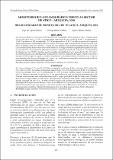Por favor, use este identificador para citar o enlazar este ítem:
https://hdl.handle.net/20.500.12958/3564Registro completo de metadatos
| Campo DC | Valor | Lengua/Idioma |
|---|---|---|
| dc.contributor.author | Del Águila-Rivera, Jorge | - |
| dc.contributor.author | Ramos-Chávez, Cinthya | - |
| dc.contributor.author | Valdivia-Chávez, Deysi | - |
| dc.date.accessioned | 2021-07-13T00:58:32Z | - |
| dc.date.available | 2021-07-13T00:58:32Z | - |
| dc.date.issued | 2021-06 | - |
| dc.identifier.citation | Inf Inst Mar Perú 48(2), 2021, p. 275-281 | es_ES |
| dc.identifier.issn | 03787702 | - |
| dc.identifier.uri | https://hdl.handle.net/20.500.12958/3564 | - |
| dc.description.abstract | La temperatura superficial del mar osciló de 14,16 °C en septiembre a 17,44 °C en febrero, a 100 m cambió de 12,13 °C en septiembre a 13,99 °C en julio, se presenció rezagos de Aguas Subtropicales Superficiales (ASS) en febrero. El oxígeno superficial presentó tenores mayores a 4,0 mL/L en febrero, entre 2,0 y 4,0 mL/L el resto del año, presentó una proporcionalidad directa con el pH. Las concentraciones de nutrientes estuvieron dentro de los rangos promedio superficiales publicados para la costa de Perú. El componente planctónico mostró volumen promedio de 1,38 mL.m-3, la dominancia de fitoplancton fue 73,83%, mientras que la densidad de fitoplancton tuvo promedio de 124 x103 cel.L-1. Se reportó presencia del dinoflagelado Protoperidinium obtusum indicador de Aguas Costera Frías (ACF) durante el 2018 excepto en agosto y octubre. Se presentó la diatomea nerítica Coscinodiscus sp.1 como la más abundante de febrero a diciembre a 1 y 5 mn. Las condiciones oceanográficas indicaron desarrollo de procesos de afloramiento desde abril a diciembre. | es_ES |
| dc.description.abstract | ABSTRACT: Sea surface temperature ranged from 14.16 °C in September to 17.44 °C in February. At 100 m it changed from 12.13 °C in September to 13.99 °C in July. Surface oxygen was greater than 4.0 mL/L in February, between 2.0 and 4.0 mL/L the rest of the year, and was directly proportional to pH. Nutrient concentrations were within the mean surface ranges published for the Peruvian coast. Plankton showed an average volume of 1.38 mL.m-3, phytoplankton dominance was 73.83%, while phytoplankton density averaged 124 x103 cel.L-1. In 2018, except in August and October, we reported the presence of the dinoflagellate Protoperidinium obtusum, which is an indicator of Cold Coastal Waters (CCW). The neritic diatom Coscinodiscus sp.1 was present as the most abundant from February to December at 1 and 5 nm. Oceanographic conditions indicated the development of upwelling processes from April to December. | - |
| dc.language.iso | spa | es_ES |
| dc.publisher | Instituto del Mar del Perú | es_ES |
| dc.relation.ispartofseries | Informe Imarpe;48(2), 2021 | - |
| dc.rights | info:eu-repo/semantics/openAccess | es_ES |
| dc.rights.uri | https://creativecommons.org/licenses/by/4.0/ | es_ES |
| dc.source | Instituto del Mar del Perú - IMARPE | es_ES |
| dc.source.uri | Repositorio Digital IMARPE | es_ES |
| dc.subject | Fitoplancton | es_ES |
| dc.subject | Protoperidinium obtusum | es_ES |
| dc.subject | Coscinodiscus sp | es_ES |
| dc.subject | Oceanografía | es_ES |
| dc.subject | Dinoflagelados | es_ES |
| dc.subject | Arequipa | es_ES |
| dc.title | Monitoreo bio-oceanográfico frente al sector de Atico - Arequipa, 2018 | es_ES |
| dc.title.alternative | Bio-oceanographic monitoring off Atico - Arequipa, 2018 | es_ES |
| dc.type | info:eu-repo/semantics/article | es_ES |
| dc.publisher.country | Perú | es_ES |
| dc.subject.ocde | http://purl.org/pe-repo/ocde/ford#1.05.11 | es_ES |
| Aparece en las colecciones: | Informe vol. 48(2) 2021 | |
Ficheros en este ítem:
| Fichero | Descripción | Tamaño | Formato | |
|---|---|---|---|---|
| Informe 48-2 artículo8.pdf | 3,67 MB | Adobe PDF |  Visualizar/Abrir |
Este ítem está sujeto a una licencia Creative Commons Licencia Creative Commons

